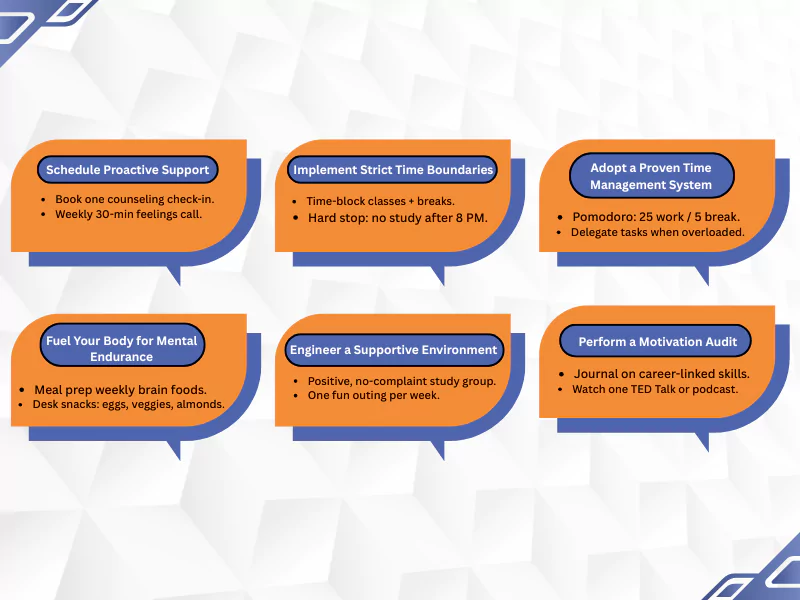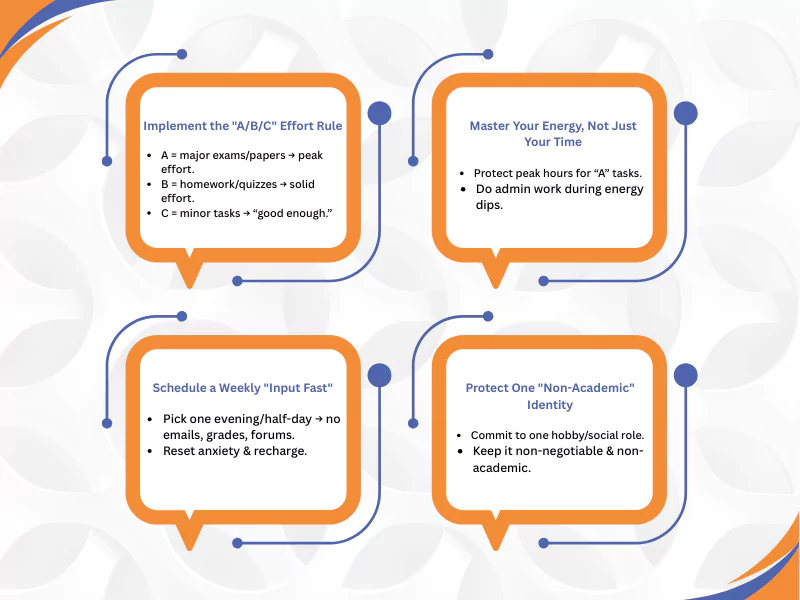The pressure to excel in the world of higher education can be immense. For any student, managing multiple assignments, exam preparation, and making time for personal commitments often feels like a marathon. While some stress is a regular part of academic life, a prolonged state of exhaustion can signal a more serious issue: academic burnout. This condition, also known as school burnout, is more than just feeling tired; it’s a state of chronic physical, emotional, and mental exhaustion that can severely impact your well-being and academic performance.
This guide is dedicated to providing a comprehensive roadmap for recognizing and overcoming academic burnout, transforming the struggle of your educational journey into a successful one.
Table of Contents
ToggleWhat Are the Signs of Student Burnout?
If you are wondering what academic burnout feels like, it’s often a slow fade, not a sudden snap. You might dismiss the early signs as typical student stress, but the following symptoms of academic burnout can accumulate over time. Acknowledging that you feel stressed more often than not is a crucial first step.
Emotional Exhaustion
This is the core symptom of burnout. You may feel drained, cynical, and detached from your studies. A sense of dread or frustration about school-related tasks becomes common, and your overall mental health may decline. This negative emotional state makes it hard to engage with your coursework.
Physical Exhaustion
The strain isn’t just mental. Burnout often leads to physical symptoms like chronic tiredness, frequent headaches, and increased susceptibility to illness. This can manifest as serious issues like insomnia and depression, which can affect every aspect of your life. You may also notice new stress responses, such as jaw tension or nail biting.
Reduced Academic Performance
Despite putting in long hours, your productivity declines. You might find it hard to concentrate, struggle with online classes, and lose confidence in your abilities. What once felt challenging now just feels like a burden.
Behavioral Changes
Irritability becomes more frequent. You might withdraw from social activities you once enjoyed and notice an increase in poor habits as a coping mechanism. A general disinterest in your school or program is a major red flag.
Let’s understand how this slowly manifests in 5 stages:
What Are the Five Stages of Burnout? First Step to Recognizing and Beating Academic Burnout

Burnout develops through distinct stages. Recognizing your current situation can help you make changes before reaching the final stage.
- The Motivation Phase: You begin a new semester with high energy and a strong commitment.
- The Onset of Stress: You begin to notice some days are harder. Your optimism wanes, and you experience common stress symptoms.
- Chronic Stress: Mental health and academic burnout are correlated. The pressure becomes more constant, and motivation starts to drop noticeably, leading to immense mental stress.
- The Crisis Stage: In this state, you feel empty, unable to manage stress, overwhelmed, and unable to cope.
- Anxiety & Depression: This is the final stage of burnout when academic crisis becomes embedded in your life, often leading to significant and ongoing psychiatric issues like severe anxiety and depression.
Am I Lazy or Burnt Out?
This is a question many students ask themselves. To begin with, laziness is typically a temporary lack of desire to act. In contrast, burnout is a state of genuine depletion where you want to be productive but feel you lack the capacity to do so. Therefore, if you’re experiencing the persistent emotional and physical symptoms listed above, it’s a clear sign of burnout, rather than a matter of willpower.
What Are the Key Causes of Academic Burnout?
Understanding the root cause of student burnout is essential for recovery. To start with, the overwhelmingness resulting from high levels of pressure is a primary driver of emotional exhaustion, which defines the condition. More specifically, key factors include:
- Intense Workload and Pressure: For example, juggling demanding courses, assignments, and tight deadlines for an upcoming exam is a significant source of stress. In fact, a study by a leading public health organization highlighted the high prevalence of this issue on campuses.
- “Always On” Culture: In addition, many academic environments promote a culture where students feel pressured to be constantly productive. As a result, this makes it difficult to set boundaries.
- Lack of Control: Similarly, feeling like you have little autonomy over your schedule or studies can lead to helplessness and frustration.
- Insufficient Support: Finally, a weak or non-existent positive support system—whether from faculty, family, or classmates—can leave you feeling isolated.
How to Recover from an Academic Burnout?

The path to recovery involves actively taking care of yourself and implementing sustainable changes. Learning how to manage academic burnout is a skill that will serve you throughout your life. These tips will help you overcome the struggle and show you how to overcome burnout.
Immediate Tips: How to Reset Your Body After Burnout
If you’re wondering what to do about severe burnout, these immediate actions can interrupt the cycle.
- Take a Genuine Break: This is the most critical first step. This doesn’t mean passively watching TV. It means scheduling a full day (or more) with zero academic work. Go to a park, visit a museum, or do something completely unrelated to your studies to give your brain a chance to reset.
- Prioritize Sleep: Create a non-negotiable sleep schedule. Turn off screens an hour before bed and avoid studying in your bedroom. This trains your brain to associate your bed with rest, not stress.
- Practice Mindful Breathing and Meditation: Use a simple technique, such as the 4-7-8 method: inhale for 4 seconds, hold for 7 seconds, and exhale for 8 seconds. Do this for just two minutes when you feel overwhelmed. This is a practical approach to managing stress in real-time.
- Engage in Gentle Physical Activity: A brisk 20-minute walk outside can be more effective than a high-intensity workout when you’re depleted. It boosts endorphins without further exhausting your system.
Long-Term Strategies: How to Undo Academic Burnout for Good
Recovery and prevention require building practical, resilient habits into your daily life. This is how to break a burnout cycle permanently with actionable steps:

Schedule Proactive Support
Don’t wait until you’re in crisis. Look up your university’s counseling services and book a single “check-in” session with a mental health counselor. Frame it as proactive academic coaching.
Additionally, schedule a 30-minute weekly call with a supportive friend or family member specifically to discuss how you’re feeling, not just what you’re doing. You can also read our other guide, “Stress Management for Students.”
Implement Strict Time Boundaries
Move beyond a simple to-do list.
- Use “time blocking” in your digital calendar.
- Schedule your classes and study sessions, but, more importantly, schedule in “Non-Academic Time.”
- Create a hard stop for studying each night, for example, 8 PM.
- After that time, your focus shifts entirely to hobbies, relaxation, or socializing.
This is how you rearrange your schedule to enforce a better work-life balance.
Adopt a Proven Time Management System
Instead of just “working hard,” work smart. Work with intense focus for 25 minutes, then take a mandatory 5-minute break to stand up, stretch, or get water. This system prevents mental fatigue, procrastination, and makes large projects less daunting.
When your schedule is so overloaded that even techniques like this aren’t enough, it may be time to delegate strategically. Services that let you take my online class for me can be a powerful tool to reclaim your time and focus on your most critical subjects.
Fuel Your Body for Mental Endurance
“Eating healthy” is too vague. The practical approach is to meal prep or stock up on brain-boosting snacks. Spend one hour on Sunday preparing items such as hard-boiled eggs, cut vegetables, and portions of almonds. Keep these on your desk to avoid energy crashes and the temptation of sugary snacks during long study sessions.
Engineer a Supportive Environment
Be intentional about your social circle. Form a study group with a strict “no complaining” rule, focusing only on productive collaboration. Proactively schedule one social outing per week that has nothing to do with school work. This makes your social life a source of recovery, not another source of stress.
Perform a “Motivation Audit”
Spend 20 minutes journaling on this specific prompt: “What is one specific skill I am learning right now that will help me in the career I want?” Then, find one TED Talk or podcast episode featuring a leader in your field. This reminds you of the purpose behind the pressure.
Freeing up the mental space to do this is crucial; if an entire course is draining your passion, getting help for that specific Online class can be the key to focusing on what truly matters to you.
How to Prevent Burnout in School?
While recovery is crucial, the ultimate goal is to learn how to prevent burnout in school before it even begins. The best way to combat burnout is to establish a system of strategic habits that serve as your first line of defense, protecting your energy and motivation.

Implement the “A/B/C” Effort Rule
To start with, not all assignments are created equal. At the start of each week, categorize your tasks: ‘A’ tasks (major exams, final papers) get your peak effort. ‘B’ tasks (standard homework, quizzes) get a solid, efficient effort. ‘C’ tasks (minor readings, participation posts) get a “good enough” effort. By doing so, you prevent yourself from wasting top-tier mental energy on tasks of low impact.
Master Your Energy, Not Just Your Time
In addition, identify your peak cognitive hours (e.g., 10 AM – 12 PM) and protect them fiercely for your most demanding ‘A’ tasks. Meanwhile, schedule administrative or less creative work (like answering emails or organizing notes) during your energy lulls (e.g., mid-afternoon). Ultimately, working with your natural energy cycles is more sustainable than forcing focus when you don’t have it.
Schedule a Weekly “Input Fast”
Furthermore, choose one evening or a half-day per week where you completely disconnect from all academic inputs. No checking grades, no opening university emails, no browsing online forums. As a result, this creates a critical psychological buffer, stops the constant drip of low-grade anxiety, and allows your nervous system to reset fully.
Protect One “Non-Academic” Identity
Finally, actively schedule and defend one hobby or social role that has zero connection to your academic life. Whether it’s playing in a band, volunteering, or being on a sports team, this activity is a non-negotiable appointment. In turn, it reinforces your sense of self beyond your GPA and provides a reliable escape hatch when the pressure mounts.
How Long Does it Take to Recover from Academic Burnout?
The recovery timeline for academic burnout varies from student to student. It depends on how long you’ve been experiencing symptoms and the severity of the burnout.
For some, a few weeks of intentional rest and lifestyle changes can make a significant difference. For others, especially those in the habitual burnout stage, it might take several months. It’s essential to be patient with yourself.
Remember, it took a long time to reach this point of exhaustion, and it will take time to recover and build new, healthier habits physically.
Conclusion
Hopefully, this step-by-step guide to recognizing and beating academic burnout has been helpful. Academic burnout is a serious condition, but it is not a life sentence. By learning to recognize the symptoms, understanding the causes, and taking intentional steps to manage them, you can focus better on learning without exhausting the mind and body. This involves prioritizing your well-being, building a strong support system, and cultivating a balanced and sustainable approach to your academic life.
Frequently Asked Questions
1. What is the fastest way to cure burnout?
The fastest way to begin recovery is to take an immediate and complete break from the source of stress. Unplug for a few days, prioritize sleep, and set aside time for relaxing activities. This initial reset is crucial.
2. What does severe burnout look like?
Severe burnout involves a complete loss of motivation, deep emotional exhaustion, cynicism towards your studies, and significant physical symptoms like chronic fatigue or insomnia. It feels like you have nothing left to give.
3. How to break a burnout cycle?
Breaking the cycle requires consciously building in periods of rest. In addition, it involves learning to say “no” to new commitments and seeking social support. Moreover, focusing on wellbeing and meditation can help restore balance. At the same time, taking strategic academic guidance provides direction. Finally, reconnecting with hobbies outside of daily school tasks allows you to rebuild your identity beyond academics.
4. What percent of students feel burnout?
The prevalence of student burnout is alarmingly high. For instance, according to recent reports, as many as three out of four college students (75%) have faced burnout. What’s more, the issue is especially critical for those nearing graduation, with a 2023 study showing that over 80% of college seniors experienced it.
5. Why do I get burnout so easily?
Susceptibility can be linked to factors like perfectionistic tendencies, a high-pressure schoolwork environment, a lack of effective coping mechanisms, or an inadequate support system. Therefore, understanding your personal triggers is key to prevention.

